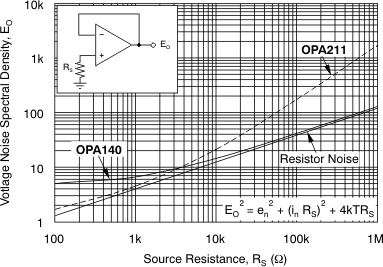JAJSGT8F June 2010 – March 2023 OPA140 , OPA2140 , OPA4140
PRODUCTION DATA
- 1
- 1 特長
- 2 アプリケーション
- 3 概要
- 4 Revision History
- 5 Pin Configuration and Functions
- 6 Specifications
- 7 Detailed Description
- 8 Application and Implementation
- 9 Device and Documentation Support
- 10Mechanical, Packaging, and Orderable Information
パッケージ・オプション
メカニカル・データ(パッケージ|ピン)
サーマルパッド・メカニカル・データ
発注情報
7.3.4 Noise Performance
Figure 7-1 shows the total circuit noise for varying source impedances with the operational amplifier in a unity-gain configuration (with no feedback resistor network and therefore no additional noise contributions). The OPA140 and OPA211 are shown with total circuit noise calculated. The op amp contributes both a voltage noise component and a current noise component. The voltage noise is commonly modeled as a time-varying component of the offset voltage. The current noise is modeled as the time-varying component of the input bias current and reacts with the source resistance to create a voltage component of noise. Therefore, the lowest noise op amp for a given application depends on the source impedance. For low source impedance, current noise is negligible, and voltage noise generally dominates. The OPAx140 family has both low voltage noise and extremely low current noise because of the FET input of the op amp. As a result, the current noise contribution of the OPAx140 series is negligible for any practical source impedance, which makes these devices the better choice for applications with high source impedance.
The equation in Figure 7-1 shows the calculation of the total circuit noise, with these parameters:
- en = voltage noise
- In = current noise
- RS = source impedance
- k = Boltzmann's constant = 1.38 × 10–23 J/K
- T = temperature in kelvins (K)
For more details on calculating noise, see Section 7.3.5.
 Figure 7-1 Noise Performance of the OPA140 and OPA211 in Unity-Gain Buffer Configuration
Figure 7-1 Noise Performance of the OPA140 and OPA211 in Unity-Gain Buffer Configuration